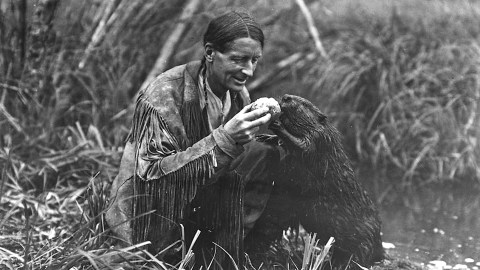A fake Tibetan monk and the charlatan who almost saved the world

Credit: BiblioArchives / LibraryArchives, CC BY 2.0 / Wikimedia Commons
- Occasionally the actions of charlatans have unintended consequences that lead to great things.
- Faux-Tibetan abbot Tuesday Lobsang Rampa was lauded by the Dalai Lama but was actually an English plumber named Cyril.
- Archibald Belaney — who passed himself off as a Native American called Grey Owl — became a hugely influential and pioneering conservationist.
Charlatans fascinate me. Though mostly incredibly dangerous characters, the unintended consequences of their actions sometimes lead to great things, for which they are often never given credit. Don’t get me wrong, though, few things give me greater pleasure than seeing a charlatan exposed, like the English occultist and High Priest of Wicca Alex Sanders (1926-88), the self-styled “King of the Witches” no less, and also known as Verbius. Sanders was exposed for conning his followers when he took members of the press to Alderley Edge in Cheshire to raise a man from the dead using an ancient summoning. The successful stunt propelled Sanders to fame. However, years later, his ex-wife revealed that, not only did he not resurrect the man, but the summoning itself was just a Swiss roll recipe read backwards. I do sometimes wonder where we’d be without them though.
Take Tuesday Lobsang Rampa (1910-81), who has been called the greatest hoaxer that the field of Tibetan studies has ever known. Apparently the son of an aristocrat who worked for the Dalai Lama’s government, Rampa was recognized as an incarnated Tibetan abbot and medical lama. He grew up in Lhasa, where he was looked after by Old Tzu, a seven-foot-tall retired monk policeman, and he later authored many bestselling books including The Third Eye, which sold half a million copies, and Living with the Lama, which was dictated to him by his cat, Mrs. Fifi Greywhiskers.
“Everything Dr. Rampa wrote is 100 per cent true,” says his website to this day. However, Heinrich Harrer, the legendary Austrian mountaineer, former Waffen-SS soldier, ice-rink builder to the Dalai Lama, and author of Seven Years in Tibet, didn’t agree and took it upon himself to out Rampa as a fraudster. His findings were shocking. Harrer discovered that Rampa had never been to Tibet, didn’t speak any Tibetan, and was actually a plumber from Plympton, Devon, whose real name was Cyril Henry Hoskin.
Rather than admitting to conning the public, Rampa wrote another book to explain himself titled The Rampa Story, in which he admitted that, yes, he used to be Cyril Hoskin, but he stopped being Hoskin after falling out of a tree as he was trying to photograph an owl. While he lay on the ground, the spirit of a monk sidled up to him and offered to switch bodies. Hoskin then assumed the soul of the monk.
Interestingly, despite all of this conning, Rampa was an incredibly influential figure. American Tibetanologist Donald S. Lopez Jr. discovered, when mentioning Rampa’s bestselling books to his contemporaries, that several cited Rampa as being the person who introduced them to and got them obsessed with the subject of Tibet. Despite being a total fraud, he was thanked for his work by many, including the Dalai Lama.
Then there was Grey Owl (1888-1938), a Native American conservationist who first came to global fame with the publication of his 1931 memoir The Men of the Last Frontier, which attracted rave reviews and made him an international star. It tells the story of his life, from his birth in Rio Grande to a New Mexico Apache Indian mother and Scottish father, both of whom were performers for Buffalo Bill’s Wild West Show (Grey Owl would later serve as a knife-thrower in this same show), to his studies under Ojibwa chief Ne-Ganikabo, and his attempts at conservation, most notably in trying to conserve beavers. The book comes with a foreword that explains that it was written in many camps where Grey Owl was based, and that the manuscript was not an easy read to begin with. Not because of the nature of the subject, but because it was typed up by a French-Canadian “who knew little English.”
Grey Owl originally was a fur trapper; however, after killing a mother beaver one day, he discovered her two young kittens and decided to adopt them. It was to be a transformative experience, which led him to pursue a life of campaigning for the preservation of all wildlife. He even set up a beaver sanctuary in Manitoba’s Riding Mountain National Park.
Grey Owl wasn’t in fact Native American at all, but a former timber company clerk from Hastings in the UK called Archibald Stansfeld Belaney.
The book was a huge success and led to Grey Owl touring the world, from America to the UK, where he met the Royal Family at Buckingham Palace, to spread the word of conservation. The non-stop lecture tours (which at one point included 138 talks in three months) took a toll on him, and he became physically exhausted to the point where, on returning to his home, a cabin on Lake Ajawaan in Saskatchewan, he became ill, fell into a coma, and died a few days later.
Not long after his death, it was revealed that Grey Owl wasn’t in fact Native American at all, but a former timber company clerk from Hastings in the UK called Archibald Stansfeld Belaney. Having moved to Canada aged 18, he created a false narrative of his life when he started writing. His parents were not, nor was he, ever part of the Wild Bill shows; he was in fact raised by two spinster aunts, having not ever really known his parents. To pass himself off as Native American, he was said to have applied henna on his skin to change his complexion, and dyed his hair black. As soon as this revelation came out, it caused huge problems both for his publishers (who either had to pulp his book or republish it with his real name) and the world of conservation, as having a charlatan as a poster figure for the movement set the cause back. However, his impact on the world remains great.
“The great tragedy is that if people had acted on what he was saying, the whole ecological movement would have been advanced by at least 30 years.”
David Attenborough
In the 1930s, a ten-year-old boy sat with his brother in a hall in Leicester as Grey Owl stood on stage, wowing a crowd with his tales of Native American life, and his message of conservation. The boy’s older brother would many years later write:
“It had been a defining moment for both of us, an event which managed perfectly to combine the disparate passions which were to absorb us for the rest of our lives… [My brother] was bowled over by the man’s determination to save the beaver, by his profound knowledge of the flora and fauna of the Canadian wilderness, and by his warnings of ecological disaster should the delicate balance between them be destroyed. The idea that mankind was endangering nature by recklessly despoiling and plundering its riches was unheard of at the time, but it is one that has remained part of [my brother’s] own credo to this day.”
After the event the boys went to shake the hand of Grey Owl, and had him sign a book. They then fought over who got to keep possession of it. Despite being the younger brother by three years, David Attenborough managed to win the book off his brother Richard, and still keeps it treasured in his library to this day.
“He was a major figure, one of the first of his kind,” David would tell Richard some 50 years later. “But, sadly, his death in 1938, and the revelations that followed, plus the outbreak of war, meant that all his warnings were ignored. The great tragedy is that if people had acted on what he was saying, the whole ecological movement would have been advanced by at least 30 years.”





